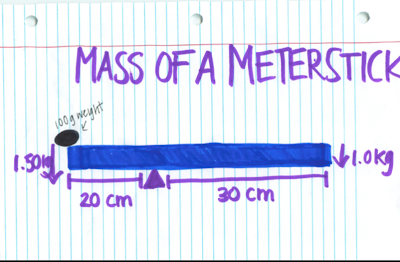Meter stick Lab
Objective: To Find the Mass of a meterstick using only a 100 gram weight
Step 1
1. Torque= lever arm times force, so in order to find the mass of the meterstick, you must first know the torque, by balancing the stick, so that the stick reads 50 cm.
2. Once you know the center of mass (middle of stick) you can use the 100 g weight for trial and error by setting the weight on the very edge of the stick
3. Once you find where the torques are equal when involving the 100 gram weight, you will be given the lever arms of both sides. The first lever arm will be that from the point where the table balances to the weight, while the other lever arm will be from the point of balance to the center of mass. (50 cm)
4. Knowing the lever arms, and the force for one side, I can go back and create an equation to figure out the force of the other side. Lets say…
The lever arm of side a times the force of side a set equal to the lever arm of side b times x (the force)
5. Once you know the torque of both sides, you can find the mass by adding the torques together and then multiplying them both by the force of gravity (9.8N)
Step 2
Torque- lever arm x force
1. First I weight the side with the 100g weight, and measure the lever arm (the point from where the weight is to where the torques are balanced)
· Lever arm= 30cmx100g (force)= 3000
2. Side without weight
· Lever arm- 20cm (from where the torques are balanced to the center of mass of the meterstick is)
· Then, I can use the equation 20x=30x1000 (setting the torques equal)
This equals=1500k=force of side with the weight= 1500kg
then to find the mass of gravity, I used 9.8N
(9.8)x.100kgx29.4=.150(9.8)x20
using the equation w=mg, I found that .98=m for the side not containing the weight
· Then to find the mass for the side without the weight, I also used the equation w=mg
So, 1.47kg=m
Adding the masses together I found that the entire mass of the meterstick is 2.45kg, this is after establishing that I needed to incorporate the force of gravity, and that I used the wrong decimal during my first attempts
I found that the method that I showed above worked, because I used the torques, which I set equal to find the weight of the entire stick using w=mg, eventually giving me the mass of the meterstick. Earlier this week in class, we learned that just because torques are equal, it does not mean that the weights or masses are equal. Torques only take into factor the lever arm and force, in this lab I had to learn how to apply torque to find the mass of an object. The reason that the meterstick balanced when the 100g weight was applied was because although the center of mass of the meter stick is at the 50cm mark, when the force was applied, the lever arm decreased because torque=lever arm xforce, and the two are indirectly proportional. On the other side without the weight, their was not a lot of force meaning that the lever arm increased, thus equaling out overall in the torque.

I really liked your mathematical explanation. Your blog was easy to follow and very thorough. I also enjoyed your visual reference at the bottom of the page. It helped me to synthesize everything visually.
ReplyDeleteHow can I do this without knowing/assuming that the center of mass of the meterstick is at 50cm?
ReplyDelete